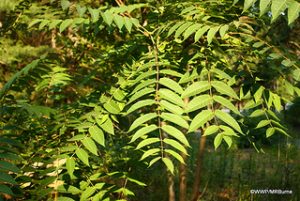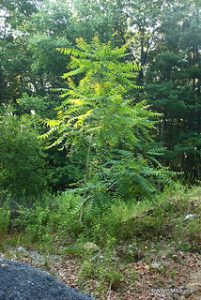Tree-of-Heaven
(Ailanthus altissima)
Family: Quassia family (Simaroubaceae)
Native Range: Central China

Overview: Fast growing deciduous tree. Leaves, roots and bark have allelopathic chemicals that prevent the grow/establishment of other plant species. Primary host of Spotted Lanternfly, an invasive pest which has numerous impacts on people and wild/agricultural plants.
Size: Can grow to ~80 ft. Sprouts can grow 10 to 14 feet the first year and seedlings can grow 3 to 6 feet in the first year.
Leaves: large compound leaves are 1-4 feet in length, alternate, and composed of 10-41 smaller leaflets. Each leaflet has one or more glandular teeth along the lower margin. The leaf margins are otherwise entire or lacking teeth.
Stem/Bark: smooth stems with pale gray bark and twigs which are light chestnut brown, especially in the dormant season. Bark eventually resembles the skin of a cantaloupe. Twigs have a large, spongy, brown pith.
Flowers: Flowers occur in large terminal clusters and are small and pale yellow to greenish. Male and female flowers occur on separate plants, with the primary differential being male flowers have an unpleasant odor while the female flowers have no scent.
Seed/Fruit: Samara (flat, papery, winged fruit). Sprouts as young as two years can produce seed.
Roots: Extensive and can grow as a colony, especially after being cut.
Reproduction:
- A single female tree can make more than 300,000 seeds per year.
- Clone from same root stock
- Root suckers can emerge ~50 ft from parent tree.
- Sprouts from a cut or damage tree.
Ecological Threat
- Forms dense thickets that replace native plants
- Releases toxins into the soil (allelopathic) that prevents the establishment of other plant species nearby.
- Seedlings and root suckers of tree-of-heaven grow rapidly and spread prolifically and thus quickly out-compete many native species for sunlight and space.
- Primary host of spotted lanternfly, an invasive pest.
Human Impacts
- Root system is capable of damaging sewers and foundations.

- Contact with the plant can cause dermatitis
Distribution and Background
First introduced to America by a gardener in Philadelphia, PA, in 1784, and by 1840 was commonly available from nurseries. The species was brought into California mainly by the Chinese who came to California during the gold rush in the mid-1800s. Today it is still found in abandoned mining sites there. The history of tree-of-heaven in China is as old as the written language of the country. It is now widely distributed across North America.
Habitat Type
It is a common tree in disturbed urban areas, where it sprouts up just about anywhere, including alleys, sidewalks, parking lots, and streets. Away from cities, tree-of-heaven is commonly seen in fields, and along roadsides, fencerows, woodland edges and forest openings.
Management Options
Due to its abundant seed production, high seed germination rate, and vegetative reproduction, elimination of tree-of-heaven requires diligence and a long-term commitment. Follow-up monitoring and treatment must be an integral part of any serious tree-of-heaven management program. Targeting large female trees for control will help reduce spread of tree-of-heaven by seed.
Biological Control
Several species are being researched but none have been approved as of 2025.
Manual Control
- Young seedlings may be pulled or dug up, preferably when the soil is moist. Care must be taken to remove the entire plant, including all roots and fragments, as these will almost certainly regrow.
- Root suckers appear similar to seedlings, but would be connected to a pre-existing lateral root, and would be nearly impossible to remove effectively.
- Girdling the tree by cutting the bark all around the trunk may kill the tree above the cut. This method is not an effective long term measure, and the roots will almost certainly regrow.
Mechanical Control
Cutting alone is usually a counter-productive strategy because tree-of-heaven responds by producing large numbers of stump sprouts and root suckers. However, for very small infestations, repeated cutting of sprouts over time can exhaust the plant’s root reserves and may be successful if continued for many years.
Chemical Control
Herbicides are currently the most effective method of controlling tree-of-heaven. Herbicides may be applied as a foliar, basal bark, cut stump, or hack and squirt treatment. Plan for numerous rounds of herbicide treatments to ensure the large root mass is killed.
Notice: Mention of Pesticide Products On This Web Site Does Not Constitute Endorsement Of Any Material. See Control and Disposal Methods for descriptions of application types and warnings.
Disposal
- Cut materials can be burned
- Stockpile on site
- Bag seeds to dry out
- The wood can be used in wood working
Look-alikes
It is important not to confuse native shrubs and trees with tree-of-heaven. Native sumacs (Rhus) and trees like ash (Fraxinus), hickory (Carya), black walnut, butternut and pecan (Juglans) can be distinguished from tree-of-heaven by having completely serrated (toothed) leaf margins.
Alternative Native Plant Species
Many attractive native trees and shrubs make excellent substitutes for tree-of-heaven and are readily available. Some examples for the eastern United States include deciduous shrubs, such as:
-
- Hickories (Carya spp.)
- Green ash (Fraxinus pennsylvanica)
- Butternut (Juglans cinerea)
- Smooth sumac (Rhus glabra)
- Staghorn sumac (Rhus typhina)